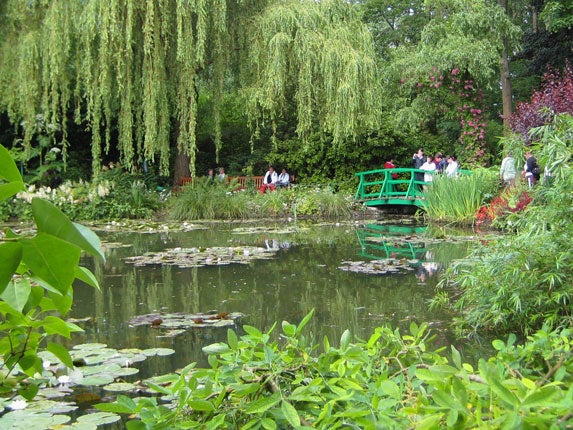Giverny: Make a good impression
Claude Monet's garden is one of the most celebrated in France, says Simon Calder

The passenger profile on the 10.20am departure from St-Lazare is very different from the usual express from Paris to Normandy. At the first stop, Vernon, half the train empties. The disembarking travellers form a straggly, impatient queue for the bus to their destination. All are seeking the village of Giverny, location for the most celebrated garden in France – and the single richest source of Impressionist joy.
The queue may get even longer after next Tuesday's Radio 4 programme, Re-painting Giverny, in which the writer and broadcaster Irma Kurtz travels to the village. Her target, as with half a million other visitors each year, is the house and garden where Claude Monet lived and worked for the second half of his long life.
You would be unlikely to stumble upon the village of Giverny, tucked away on a minor tributary of the Seine. The railway was torn up years ago, and indeed the old line has turned into a track for hikers and bikers – a more aesthetic approach than the overstuffed art bus if you prefer a one-hour walk from Vernon.
Monet's garden is a portrait created by the artist in his 40s. It occupies a swathe of tranquility where the Ile-de-France melts into Normandy. Monet sought to control those aspects of nature he could tame, cultivating a setting where he could transfer his passion to canvas. The result: a garden as a work of art.
The pink house itself is swaddled by ivy, camouflaged in the manner of a Mayan temple consumed by jungle. Walk inside, and you step into a three-dimensional Monet painting, a home energised by bright strokes of colour where you imagine Claude has just nipped out for a quick dig or dab.
Giverny's head gardener is now an Englishman, James Priest. Yet beyond a stab at formality on the slope draping down from the house there is little of the jardin anglais about it. Or rather them. There are, in fact, two gardens. The first is the Clos Normand, mimicking an artist's palette in its dainty apportioning of colour. Beyond it, separated by the D5 road (beneath which you burrow via a pedestrian subway) lies the Jardin d'Eau: the water, and lilies, and the Japanese bridge. This was the venue for Monet's exploration of light and texture, beneath a broad sky that still creates magic with les nymphéas. Paths guide you through what amounts to an outdoor studio that pre-dates Hollywood.
Double your Monet at the well-executed modern collection, the Musée des impressionnismes, that adds a valuable dimension to the gardens: its strong suit is loans from US collections. Indeed, at the fine converted watermill where I stayed, a fellow guest was in town to pick up a Monet painting that had been loaned from an American college.
Subtract the artist, and the crowds that he attracts, and what remains is still compelling. Once the day-trippers are bussed away, Giverny reclaims its status as a serene village that delivers la France profonde beautifully.
Thanks to that D5 diversion, the main street – rue Claude Monet – is little more than a quiet track that connects the garden and museum with excellent places to eat and drink – notably the Restaurant Baudy, which combines a sense of history with a superb fixed-price menu.
Ambling around Giverny delivers more surprises: someone has gone to the trouble of decorating the postboxes with Impressionist scenes. And a preposterous proliferation of vegetation has almost devoured the bus stop at the end of the village.
A final curtain of foliage ruffles down from the church perched above Giverny. Counting the gravestones, the departed appear to outnumber the living by some margin. The top tomb, drenched with flowers, is inscribed Ici repose notre bien aime Claude Monet ... Regrette de tous.
Other painters left the world only lifeless canvasses; Monet bequeathed us a garden.
'Re-painting Giverny', presented by Irma Kurtz and produced by Laura Parfitt, is broadcast on Radio 4 next Tuesday, 27 September, at 11.30am.
Travel essentials: Giverny
Getting there
* The author paid £219 for a London-Paris return on Eurostar, and a further €26.40 for the return journey from St-Lazare to Vernon (about 40 minutes each way). The connecting bus from Vernon to Giverny costs €4 (day return).
* By ferry, the most convenient port is Dieppe, served from Newhaven on LD Lines (0800 917 1201; ldlines.co.uk). Giverny is about 90 minutes by road from the port.
Staying there
* A double room at the Moulin des Chennevieres (00 33 6 81 13 77 72; givernymoulin.com) costs €80, including a vast breakfast – served outside on fine days. Cash only.
Eating there
* Restaurant Baudy (00 33 2 32 21 10 03); closed November-March.
Seeing there
* Monet's Garden (00 33 2 32 51 28 21; fondation-monet.fr/uk) opens 9.30am-6pm daily from 1 April to 1 November, admission €8.
* Musée des impressionnismes (00 33 2 32 51 94 65; mdig.fr) opens 10am-6pm daily from 1 April to 31 October, admission €6.50 (free on the first Sunday of each month).
Join our commenting forum
Join thought-provoking conversations, follow other Independent readers and see their replies
Comments